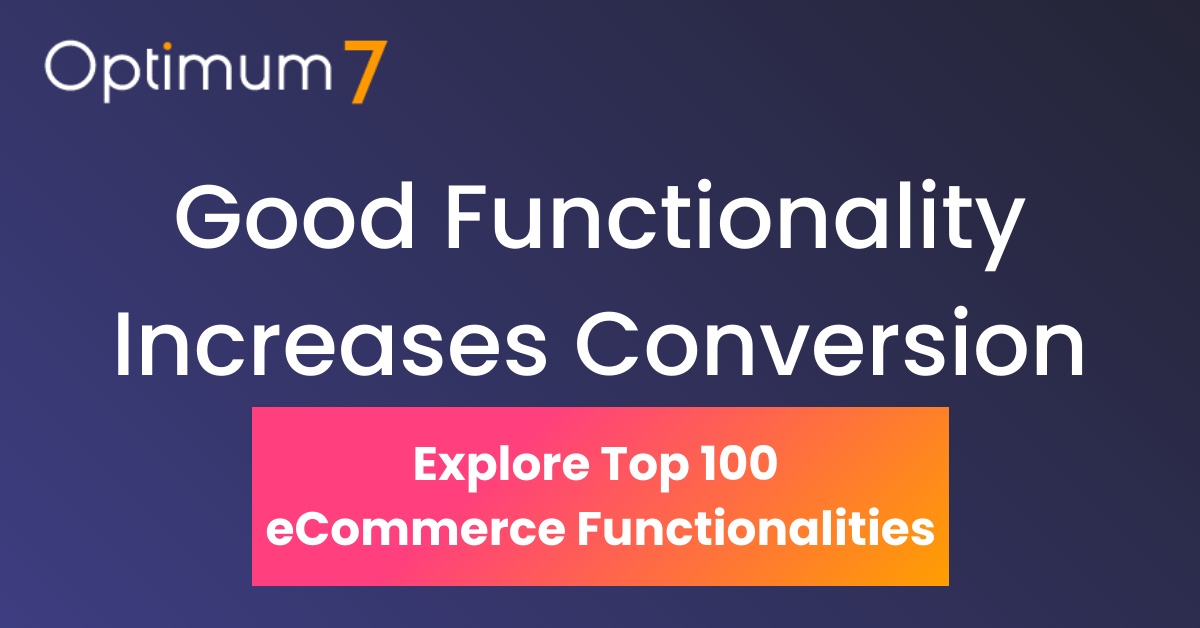If your eCommerce customers cannot find what they’re looking for on your website, it’s going to kill your conversion rates. Faceted Search and Filter is the best way to address this concern.
In fact, 41% of online shoppers will buy elsewhere if a website has a poorly designed menu. 30% of consumers will leave an eCommerce site if the search capabilities are too basic.
That’s why every eCommerce site needs to implement faceted search.
What is a faceted search?
The term is also known as faceted browsing or faceted navigation. It’s a technique used by eCommerce sites that augments traditional searches. A faceted search allows users to narrow down and refine search results by applying different filters.
Faceted search makes it possible for eCommerce products to be organized by things like size, color, gender, category, price, and much more.
Any time you’re trying to make improvements to your website, products, or services, it’s always best to follow the example of industry leaders that are having success.
Look at an industry giant like Amazon. One of the reasons why they are so big is because they have exceptional functionality for searches and filters.
In this guide, I’ll explain everything you need to know about faceted search and how it can drastically improve your eCommerce site.
Benefits of Faceted Search and Filter
80% of online consumers search for products when they land on an eCommerce site. So hopefully, at a minimum, your site already has some type of search functionality.
But with that said, a basic search feature is not enough. Let’s take a look at some of the top benefits of adding faceted search to your eCommerce website.
Improves Product Findability
Consumers typically don’t just mindlessly browse through random products online. There’s a reason why they landed on your website. They have a basic idea for something that they want or need.
Now it’s up to you to make it as easy as possible for them to find that product. This is where faceted search comes into play.
For example, if you search for “vacuum cleaner” on Amazon, you’ll get more than 40,000 results. Nobody is going to scroll through 40,000 products.
But as I said before, Amazon is a master of faceted search.
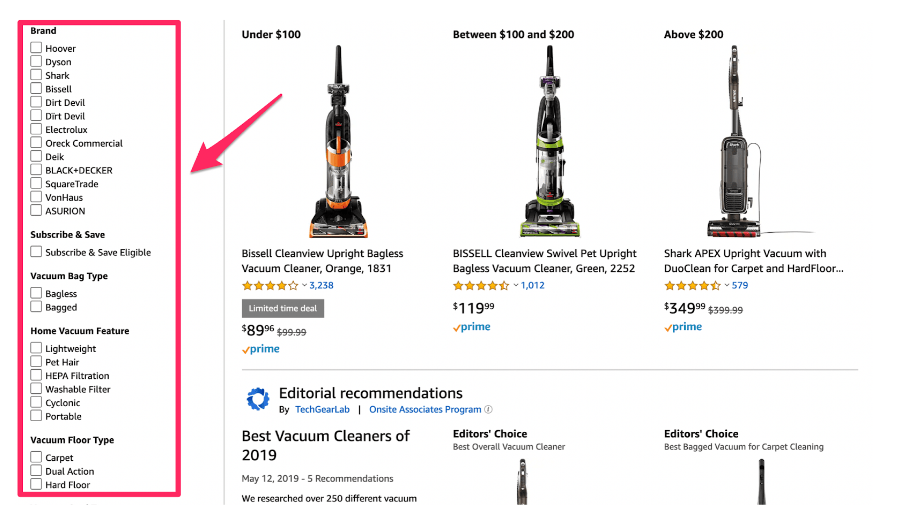
Take a look at some of the filter options on the left side of the screen.
Just by choosing a brand, vacuum bag type, and floor type, my results got narrowed down to 10 options. That’s much more realistic than 40,000.
Faceted search system is necessary for all eCommerce sites, but it’s especially crucial for those of you with extensive product catalogs. You need to be able to improve the product findability so your customers can locate what they’re looking for as fast and painlessly as possible.
Eliminates Null Search Results on Filter
By implementing faceted search, it eliminates the keyword responsibilities for your customers.
Without faceted search, visitors are forced to ask what keywords should I type in to find what I’m looking for?
In many cases, the customer may search for something that’s ultra-specific to try and narrow down the results. But if you’re products aren’t tagged properly or the keywords are off-base, then they’ll see a message that looks something like this:

As a consumer, this is extremely frustrating. Rather than retrying the search, there’s a good chance that they’ll just look elsewhere for the product.
This is bad news for you, especially if your website had what they were looking for all along. They were just unable to find it because your search functionality is limited.
But with faceted search, visitors simply need to select which facets best describes what they’re searching for.
Since you’ve set up the parameters, you know that the filtering process won’t yield any null results.
Improves Customer Experience
Every decision you make on your eCommerce site needs to benefit the customer. If a website visitor is enjoying their experience, it makes it more likely that they’ll buy something.
According to HubSpot, the customer’s ability to find what they want is the most important design feature of a website.
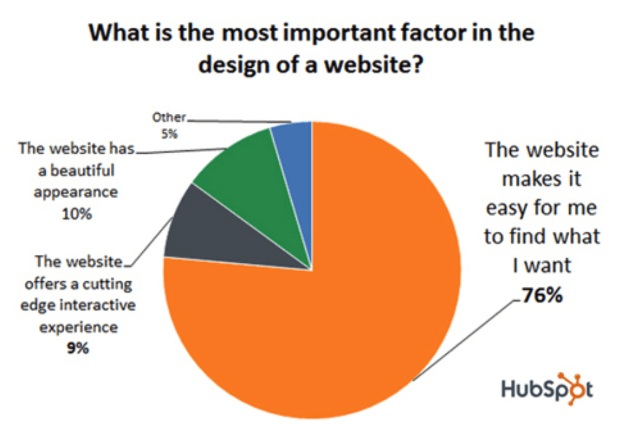
As you can see from the graph, this survey response drastically outweighed all of the other answers.
Faceted search helps set expectations for the customer as well. The number of search results based on the facets will be displayed on the page. This makes it much easier for the customer to decide if they want to keep applying more filters to narrow the results or if they’re ready to start browsing through the products.
Valuable Data-Driven Insights
You must collect lots of data to have an ongoing optimization process for your eCommerce site. The more data you have, the easier it will be for you to find trends and personalize relevant search results for your visitors.
Traditional search bars give you a good indication of what your visitors are looking for, but the search terms will usually be pretty broad. This won’t be very useful for data purposes.
But faceted search gives your customers the ability to narrow down what they consider to be the perfect product.
With each facet, the customer reveals more information about the type of products that they’re interested in. This type of data is extremely valuable.
Increase in eCommerce Site Sales
At the end of the day, everything you do needs to generate sales. All of the other benefits we’ve discussed will contribute to this overall goal of your eCommerce site.
One of the main reasons why faceted search increases eCommerce sales is because it narrows down results. This is known as the paradox of choice.
There is a famous experiment known as the Jam Study. One day at a supermarket, 24 jams were on display. The next day, just six jams were on display.
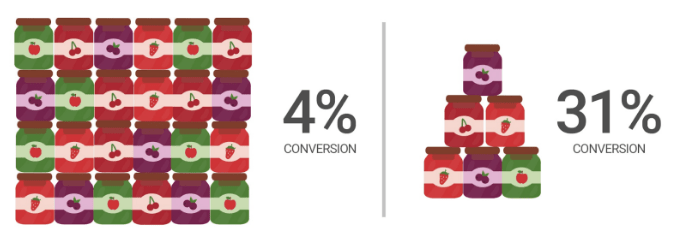
When the supermarket eliminated choices, conversion rates skyrocketed.
The same concept can be applied to online shopping. The more choices someone has, the less likely it will be that they will convert. But by giving them facets to narrow down the options, it increases their chances to buy.
Furthermore, the chances of selling to someone who is using faceted search is even higher, since all of the results they are viewing will fit the description of exactly what they need.
Faceted Search Interface and Filter Architecture
Setting up the proper site architecture for your eCommerce faceted search functionality is crucial. Otherwise, you can run into some SEO problems.
But before we get into that, let’s take a look at how you should structure your products when you’re using this technique.
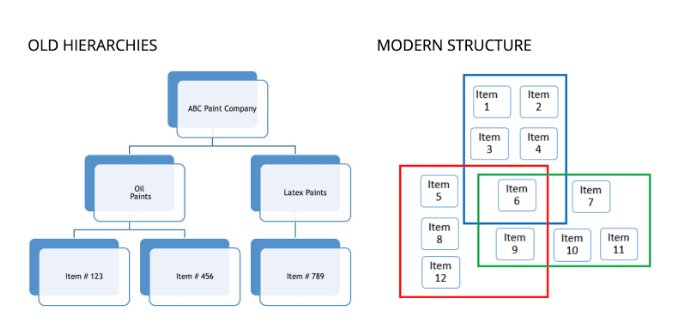
Applying a faceted search means that you need to have a modern structure, as opposed to a traditional hierarchy of pages.
When you’re creating specific categories for your multiple facets, you need to distinguish them by the level of importance. You want to make sure that your filters are user-friendly, without damaging your technical SEO.
The major problem with faceted search is that it can create duplicate content or additional URLs that are perceived as unnecessary by search engine crawlers.
The types of filters that you can use on a Faceted Search Implementation are multiple filters, thematic filters, and basic filters with specific facet options.
The number of facets can be unlimited as long as the user experience is not compromised. The user should be able to multi-select any option, select options with facet filters, and be able to refine their search via search queries.
The search results pages offering faceted filters should have price ranges and other necessary filter options. This can be done via a powerful faceted search API, faceted search REACT, or VUEJS ViewModel front end JavaScript framework to build the necessary filter user interfaces.
You might be sorting your products differently based on factors like color or size, but these filters don’t change the content itself. That’s why you need to apply “noindex” and “nofollow” tags.
Here’s an example of facets that you would add a “nofollow” tag to.
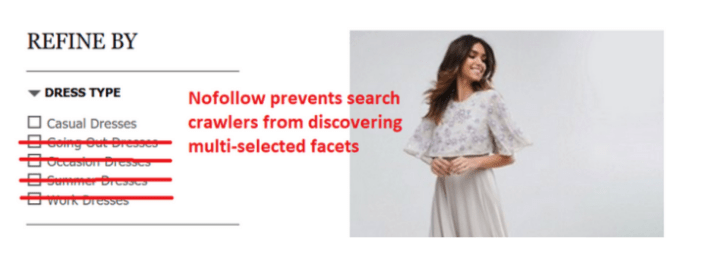
These are the best ways to make sure that your site architecture is properly set up for faceted search:
- AJAX — New URLs won’t be created after a filter is applied and sorted.
- Robots.txt — Blocks crawlers from indexing specific pages.
- Canonical tags — Directs search engines toward pages you want crawled to avoid duplicate content issues.
Just make sure you have the tools necessary to organize your site structure before you implement faceted search.
Technology – How to Build Faceted Search
Next, you need to understand the technology that drives faceted search and allows it to work on your eCommerce site. Everything that happens behind the scenes will impact the UI (user interface).
Elasticsearch is a popular solution for adding this type of advanced search to your website without having to do too much manual work on your own. The platform allows you to add search to your site while simultaneously indexing your content to increase product findability.
With JavaScript, you’re able to sort and display large datasets on your website.
There are also ways for you to build a custom API and database that will work together with your design pattern to create a functional faceted search on your website.
I’d recommend consulting with a professional to help assist you with the technology required for eCommerce faceted search.
eCommerce Platforms
No matter what type of eCommerce platform you’re using, you can implement faceted search. The way you will set up and apply the advanced search will vary based on the platform.
- BigCommerce
- Volusion
- Shopify
- 3DCart
- Miva
- Magento
- WordPress
- WooCommerce
- Oracle ATG
- SAP Hybris
- Prestashop
Setting up faceted search on some of these eCommerce platforms will be easier than others.
Since there is not just one specific way to do this, and the methods vary based on the platform, it’s in your best interest to consider a custom eCommerce solution for faceted search. But we’ll discuss this in greater detail shortly.
Best eCommerce Faceted Search Examples and Results
Now let’s take a look at some specific examples of brands that applied faceted search to their website. These projects were all completed by Optimum7.
ASMC Industrial
ASMC Industrial has thousands of products on its website. They sell nuts, bolts, washers, screws, and other tools to industrial companies using BigCommerce.
Without a proper search function on their website, their customers were forced to scroll through hundreds of results to find what they were looking for.
ASMC Industrial recognized this pain process, and added a hosted search from a third-party provider, costing $500 per month. This did not solve the problem.
It wasn’t until they added a custom eCommerce solution for faceted search that they were able to finally organize their products to make the purchase process easy for their customers.
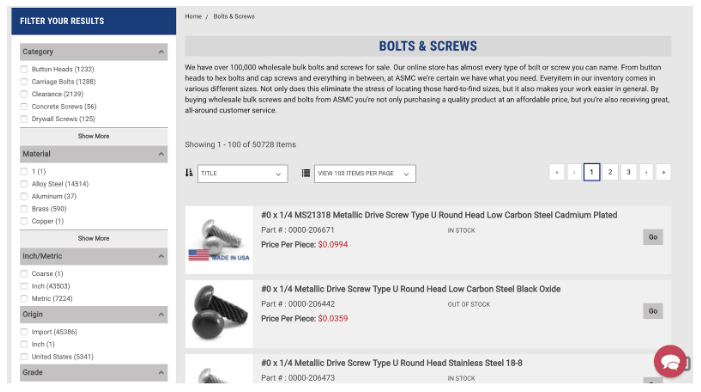
With the filtered categories on the left side of the screen, it’s quick and easy for shoppers to find exactly what they need, even if it’s as small as a screw.
Specialistid.com
Specialist ID Inc. sells badge holders online. They sell thousands of products on their Shopify website.
If you visit their site, you’ll quickly learn that all badge holders are not created equally. They needed to come up with a way for customers to find products that are best for their needs.
For example, a medical badge isn’t the same as a luggage bag tag. Some customers need heavy-duty tags or even water-resistant holders.
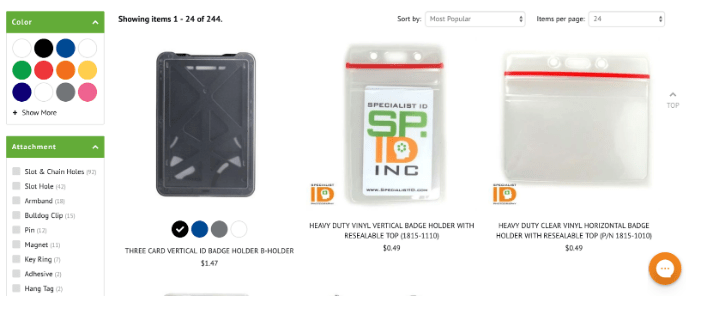
Here’s a quick look at how the eCommerce faceted search looks on their website now. In addition to category, color, and attachment, products can also be filtered by things like:
- Insert Size
- Orientation
- Rigidity
- Material Type
- Width
- Clip Type
- Additional Features
All of this makes the shopping experience that much better.
School Outlet
As the name implies, School Outlet uses its eCommerce site to sell school supplies and classroom equipment online. They use Volusion’s platform for their eCommerce needs.
Here’s an example of what the UI looks like when you’re shopping on their online store.
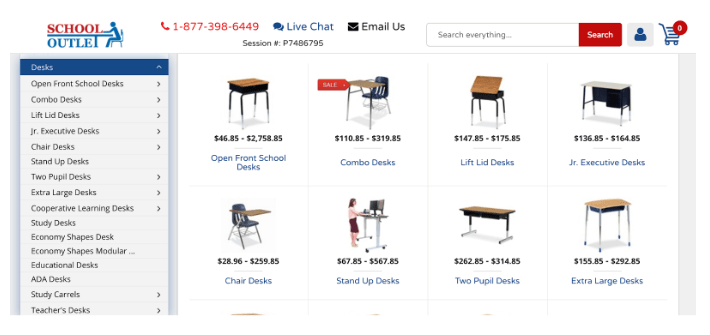
If you search for desks, you’ll see that there are more than a dozen different categories to choose from. Once you choose a category, you’ll be able to narrow down those results even further with additional dynamic facets.
Again, all of this makes it quick and convenient for shoppers to find the perfect product in seconds.
App vs. Custom Solution
As I briefly mentioned before, there are various ways to add faceted search to your eCommerce website. Depending on what eCommerce platform you’re using, there are apps available to implement eCommerce faceted search.
However, these apps are cookie-cutter. They are designed for the masses, and not intended for your specific eCommerce website.
If you look at the examples we’ve covered in this guide, you can see that all of these businesses are very different. That’s why a custom solution is a better choice to meet your needs.
By choosing a custom eCommerce solution, you won’t have to worry about the technology behind the scenes either. A professional can handle the technical specs for you.
Here at Optimum 7, we can build you a customized faceted search feature for your eCommerce website. Just contact us today to request a consultation.
FAQ – Faceted Search for eCommerce
How do you do a faceted search?
In order to create an optimal search experience, you need insight into your user’s needs and interests. When implementing faceted searches consider what they are looking for as well as which facets interest them most – this will help deliver a more relevant result set!
It’s important to have a lot of options when you’re looking for something in the store. With so many different brands and models on offer, it can be difficult to narrow down your findings without any sort of criteria at all!
How do Facets work?
Facets are a great way to narrow down your search. Pre-faceted filters can be set before you begin, and they only show results from certain collections when selected like “All available collections” or books/eBooks in the dropdown list prior to starting a new search.
What is faceted navigation SEO?
Faceted search is an in-page eCommerce navigation system that allows users to filter products according to their preferences.
This can be done using a facet menu or dropdown, where you choose what type of information about each product item interests you most – such as price range; size requirements; purchase date/timeframes, etc.
Facets are also great for narrowing down the list when looking at something like watches because there may simply be too many options available!
Similarly, avoid SEO issues by setting canonical tags on pages and ensuring Google crawls only priority content (which means any non-direct links).
What is the difference between facets and filters?
A filter is any tool that analyzes a set of content and filters out items.
Faceted navigation can be made from multiple filters, which describe the entire description in-depth for each facet or separate element within your web pages’ hierarchy structure on top of these basic categorizations like text (text), images/videos, etc…


